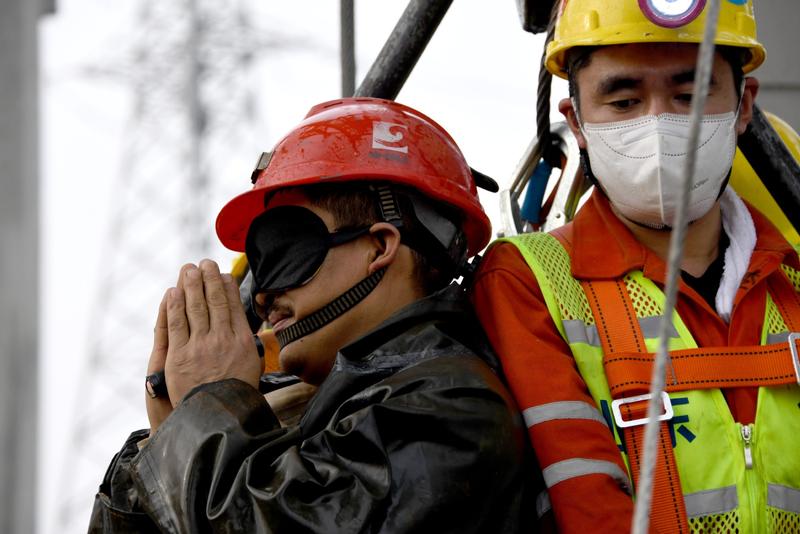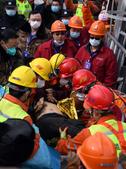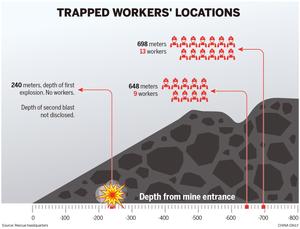11 rescued after large cavity accessed
 A miner is rescued on Sunday, 14 days after two explosions rocked the gold mine in Qixia, Shandong province.(PHOTO / XINHUA)
A miner is rescued on Sunday, 14 days after two explosions rocked the gold mine in Qixia, Shandong province.(PHOTO / XINHUA)
On Sunday morning, rescue workers unexpectedly reached a large cavity 14 days after two explosions trapped 22 workers underground at a gold mine under construction in Qixia, Shandong province.
The breakthrough proved crucial in efforts that saved 11 of the stricken miners.
The cavity was reached after two weeks of continuous attempts to clear debris from the main shaft at the mine-a major route to lift the miners to the surface.
Accessing the cavity accelerated work to save the men, who was trapped more than 600 meters underground after the explosions on Jan 10.
Xiao Wenru, chief engineer at the Ministry of Emergency Management's mine rescue center, said on Sunday, "We had predicted that it could take at least another 15 days to clear heavy obstacles from the shaft."
Around 11 am on Sunday, rescuers and ambulances stood by at the entrance to the shaft. All eyes were on cables hauling a container bucket up from a depth of more than 500 meters.
Finally, the bucket reached the surface, carrying two rescuers and one of the trapped workers. The miner, who was extremely weak, was carried to an ambulance and taken to the hospital.
Feng Anji, one of the rescuers who went down the shaft, said: "We found the miner lying curled up. He could talk, but was too weak to move."
Xinhua News Agency reported on Tuesday that the worker used his cap for 14 days to scoop up underground water.
Another 10 workers were lifted to safety within two hours of the first being found, all of them blindfolded to avoid bright sunlight.
One of these workers was injured and had to be carried to an ambulance. The remaining nine walked to ambulances with assistance.
Rescuers continued to search for the other trapped workers, before finding nine bodies. They are still trying to locate the remaining employee.
The rescuers searched an area above the mine's No 6 section, which is 698 meters from the entrance.
Chen Fei, the mayor of Yantai, which administers Qixia, said at a news conference on Monday that rescuers working below this section faced huge difficulties because of the large amount of water in that area of the mine.
"We won't stop searching until we find him," Chen said.
At the news conference, officials stood in silent tribute to those who died in the blasts.
As of Tuesday, 10 workers were confirmed to have died, 11 were alive and the fate of the other remained unknown.
Chen Yumin, leader of the rescue team, said an inspection of the area where the nine bodies were found showed the workers died in a second explosion while trying to climb to safety after the first.
The initial blast, which occurred around 1:15 pm on Jan 10 at a depth of 240 meters, caused a strong tremor and shattered the windows of a room at the mine entrance.
Thick smoke billowed from the mine, where 13 of the employees were working in one section at a depth of 698 meters from the shaft entrance, and nine at a depth of 648 meters.
The second explosion occurred around 2:45 pm, Chen Yumin said.
The blasts damaged the mine's communications system, meaning rescuers were initially unable to tell whether the miners were still alive.
The rescue headquarters said everything was being done to save the trapped workers.
Rescue forces, including teams from Beijing and the provinces of Henan and Anhui, gathered at the mine.
By Tuesday more than 600 rescue workers and related personnel from 17 teams, along with firefighters, were at the site, according to the headquarters.
 One of the workers is brought to safety. (CHEN HAO / XINHUA)
One of the workers is brought to safety. (CHEN HAO / XINHUA)
Two-pronged operation
To save the miners as quickly as possible, the headquarters conducted a two-pronged operation-clearing the shaft and drilling holes to search for signs of life, provide ventilation and deliver supplies.
Experts said unexpected difficulties were encountered in both operations.
For two weeks, rescuers found it extremely hard to clear the shaft, which was badly damaged and blocked by debris, including cables and steel wires.
Li Lei, from the China National Coal Group, which was responsible for clearing the shaft, said, "More than 70 percent of the debris comprised steel objects."
Ma Zhimin, deputy leader of the team clearing the shaft, said that after the workers encountered a severe blockage 340 meters down, it took them three days to clear debris 7 meters deep.
On Jan 19, the team found a similar blockage at a depth of 350 meters, Ma added.
To speed work to remove the debris, workers customized some equipment used to clear the shaft.
"As a result, the number of workers clearing debris blocking the shaft rose to seven to nine people at any one time, up from just two," Ma said.
However, experts estimated that some 1,300 cubic meters of debris weighing about 70 metric tons was still blocking the shaft at a depth of 350 meters to 450 meters. On Thursday, they predicted it could take at least another 15 days to clear the shaft.
Then, on Sunday, rescuers clearing the shaft reached the cavity.
After being brought to the surface through the cleared shaft, one worker still clutching an illuminated flashlight placed his hands together in a gesture of thanks to the rescuers.
Another of the rescued workers said, "I want my family to know that I am alive."
Qin Chengyong, leader of the medical rescue and treatment team, said on Monday, "The 11 workers are in stable physical and psychological condition and their lives are not at risk."
The workers were undergoing treatment recommended by experts working in the fields of critical care, psychology and nutrition, Qin said.
During the rescue operation, workers drilled 10 holes to search for the miners and to bring them to the surface in the event of the shaft not being sufficiently cleared of debris.
Two of the holes had to be abandoned-one due to a deviation in the drilling work that could not be corrected, and the other because the drill became stuck after hitting crushed rock.
Du Bingjian, a chief engineer at the National Mine Emergency Rescue Center, said, "Mines of this nature have strata composed of igneous rocks, which are the hardest type."
Drilling can easily deviate in such conditions, Du added.
Eleven miners were located on Jan 17 through a hole about 22 centimeters in diameter drilled to a depth of nearly 600 meters in a section of the mine where workers were reportedly trapped.
Next day, a hole 31.1 centimeters in diameter drilled to a depth of 629 meters also reached this section. According to the rescue headquarters, this was the deepest hole workers had drilled in recent years. However, rescuers were unable to locate any of the other miners.

Life underground
Chen Fei, the mayor, said, "When the hole reached them, the miners and the rescuers were overjoyed."
A cable placed down the hole became a lifeline for the trapped workers, as rescuers used it to send them communication devices, along with enough food and other supplies to last for a week.
Song Xicheng, deputy director of the medical rescue team, said on Jan 19 that after receiving four batches of life-sustaining nutrient solutions delivered down the hole, 10 of the trapped workers had regained their strength.
"I gained the impression that one experienced worker had urged his colleagues to remain hopeful, despite the difficulties they were in," Song said.
After sending food to the miners, rescuers found two handwritten notes attached to the cable when they pulled it up.
The first said the trapped workers were exhausted and in urgent need of stomach medicine, painkillers, bandages and anti-inflammatory drugs. It also said there was smoke and a lot of water in the area they were in.
Acting on this information, rescuers drilled two more holes to drain underground water to keep the workers safe.
On the recommendation of rescue headquarters, the 10 miners moved to a safer area near one of the newly drilled holes before being lifted to the surface.
The second note read, "Please send down another telephone to us as backup."
When they spoke to rescuers by phone, the miners asked for pickles, ham and porridge made from millet.
In addition to nutrient solutions, rescuers sent porridge, thermometers, tissues, notepaper, blankets and shoes down to the miners.
Each container of food was lowered with a note attached, which read: "We are waiting for all of you. Stay cheerful."
Volunteers act
Local volunteers also offered their help from the start of the rescue operation.
Wang Haiqing, from Laiyang, a city neighboring Yantai, who drove a crane to the scene, said: "I wish I could have hugged all the trapped workers after they were lifted to the surface. I miss home after being here for just two days, as must those who have been underground for so long."
Du Jiancai sent 22 packs of millet to the rescue site after hearing that the minerswanted porridge.
A local resident, who did not give her name, sent hot dumplings to the rescuers.102.1
"It's not easy working in chilly temperatures at the site for many days. I just wanted to do something for them," she said.


